Garden airgun shooting: these are the things you need to know
If you have access to a garden you can practice and have fun says Mike Morton.
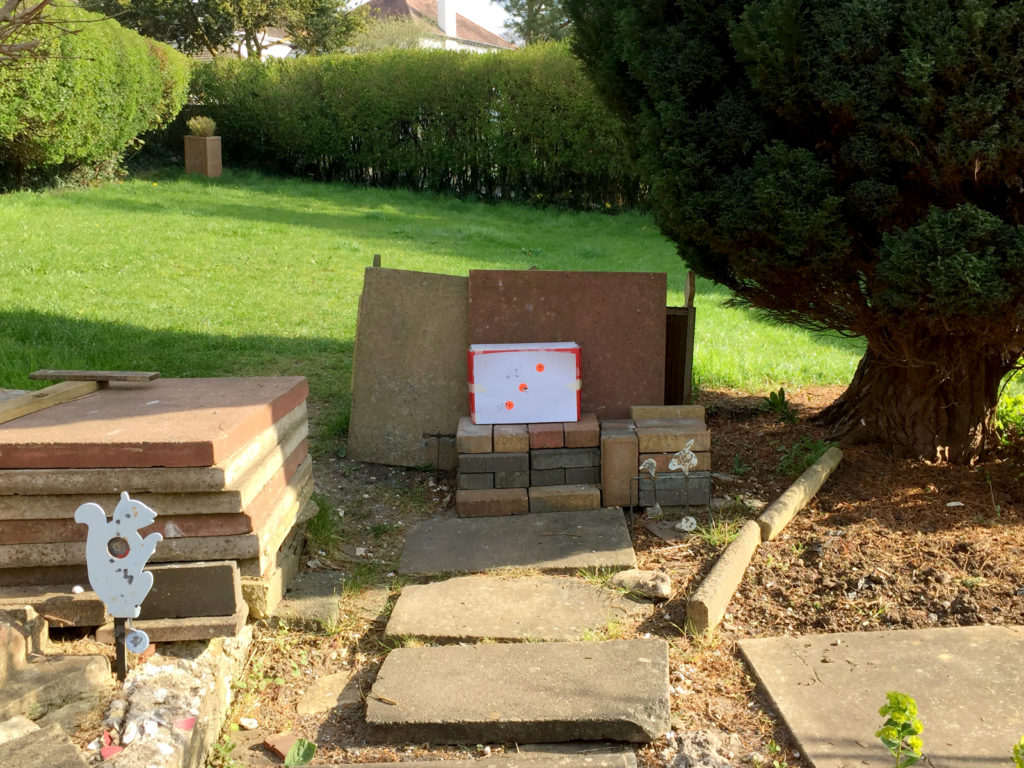
If you have access to a garden, and that also includes a smaller one, then you can take part in garden airgun shooting. (Read our list of best air rifle targets for garden airgunning at home.)
Unlike a regular shooting range, a garden is always open for business provided you follow the laws on garden airgun shooting. With a few legal and safety points adhered to, the garden is an excellent place to shoot our airguns, allowing us to plink to our heart’s content, practise our shooting skills or even set up and test a new rifle and scope combo.
If you don’t own a garden of your own, try persuading a friend or relative to let you shoot in theirs. And who knows? You may end up converting somebody else to the sport into the bargain.
The key to unlocking all this is to find the perfect blend of safety, security, fun and freedom. The garden gives us a massive opportunity to enjoy our hobby easily and cheaply, but this comes with a huge commitment to safe shooting and our legal responsibilities to other people, their pets and their property.
Garden airgun shooting law
While we have the legal right to shoot airguns on our own land, we must make sure that any pellets do not go over the boundary of our property. It is an offence to fire a pellet beyond the land where we have permission to shoot, unless the occupier of the neighbouring land has also given us permission.
Where someone under 14 is shooting and a pellet goes beyond the boundary, both the young person and the adult supervising them can be prosecuted. Allowing our shot to go into or over another person’s property constitutes the tort of Trespass. (Read airgun laws you should know.)
A young person who is aged 14 to 17 can borrow an airgun, and its ammunition, and use it without supervision on private premises where they have permission.
Someone aged under 14 years can still use an airgun, but they must be under supervision on private premises with permission from the occupier, which will normally be the owner or tenant. The person who supervises a shooter aged under 14 must be at least 21 years old themselves.
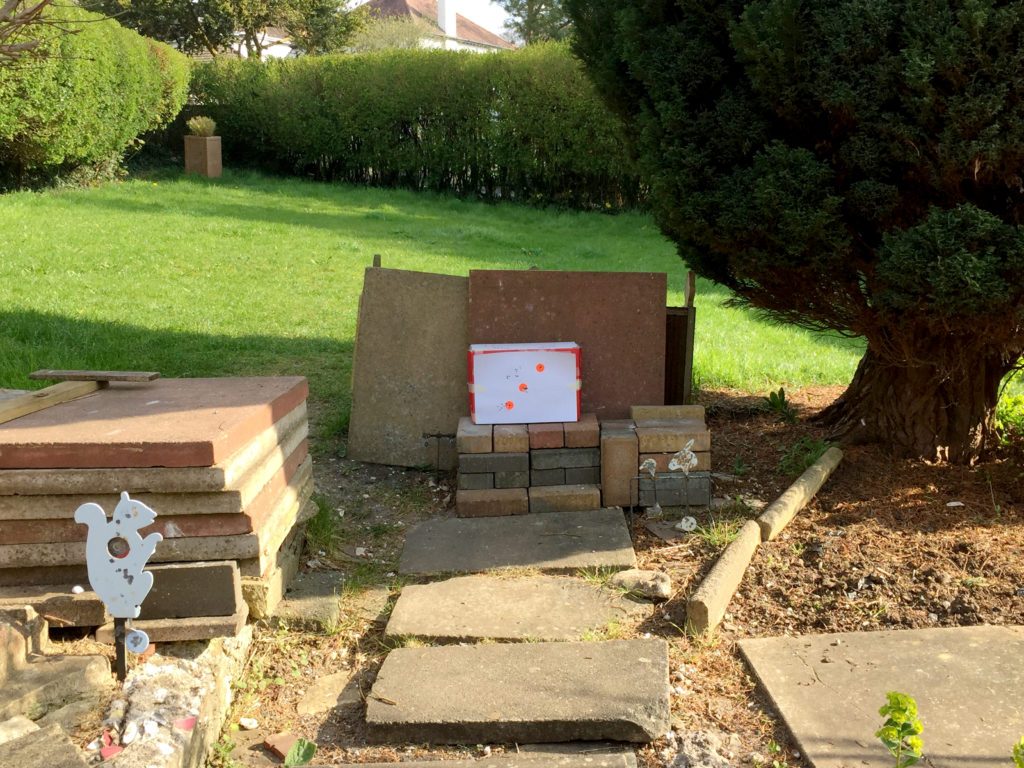
The garden is an excellent place for us to shoot our airguns and enjoy our sport, provided not a single pellet or BB ever goes beyond our boundary
These offences could be committed, for example, when someone is shooting in their garden close to a public highway and a pellet ricochets onto it, injuring someone.
Nevertheless, the garden range remains a fundamentally safe place to shoot as long as everyone displays correct gun-handling techniques, sticks to best shooting practices and always makes sure they are using a safe backstop.
Garden airgun shooting: the backstop
A backstop is anything that will safely stop a pellet should you either miss your intended target or should it go through the target. Depending on the lie of the land, a backstop can be the ground itself or a brick or stone wall, but in many cases you’ll have to create your own. (Read our list of the best airgun pellets.)
The best backstops I’ve ever seen are ones that have been purpose-built from sheets of steel, but most people probably won’t have the necessary tools or materials to build a structure like this at home. Alternatively, backstops can be built up with bricks or concrete paving slabs.
Although they are heavy to manoeuvre into position, concrete slabs are extremely safe once placed because, like heavy sheet metal, they will cause any errant pellets to safely flatten out on impact. A lighter alternative is to pick up a few Kevlar panels from an army surplus store.
This synthetic fibre is excellent at absorbing pellet strikes, but does degrade with extended use as it is designed to be replaced immediately after being hit by an incoming bullet or piece of shrapnel, not used repeatedly for stopping airgun pellets.
I know airgun shooters who use ceramic body armour, again bought from a surplus store, but in my opinion these chest- and back-sized plates are too small to be useful as a backstop.
Sandbags, on the other hand, either filled with sand or soil, do make an excellent backstop when they are piled high enough, although your garden might be starting to resemble a WWI trench by this point, which your partner might not be too happy about!
In my own garden, I like to place a few spinners and a homemade pellet-catcher in front of a backstop made of piled bricks and paving slabs. My lawn slopes upwards, so even if both the target and the backstop were missed, the stray pellet would just go into the ground as an extra precaution.
Neighbours when garden airgun shooting
While we have the legal right to shoot in our garden, it’s worth sparing a thought for our neighbours, most of whom will have no experience of airguns.
Someone like this isn’t necessarily anti-shooting, they probably just don’t know anything about it, so it’s a good idea to explain what you’re going to be doing before you actually start to open fire.
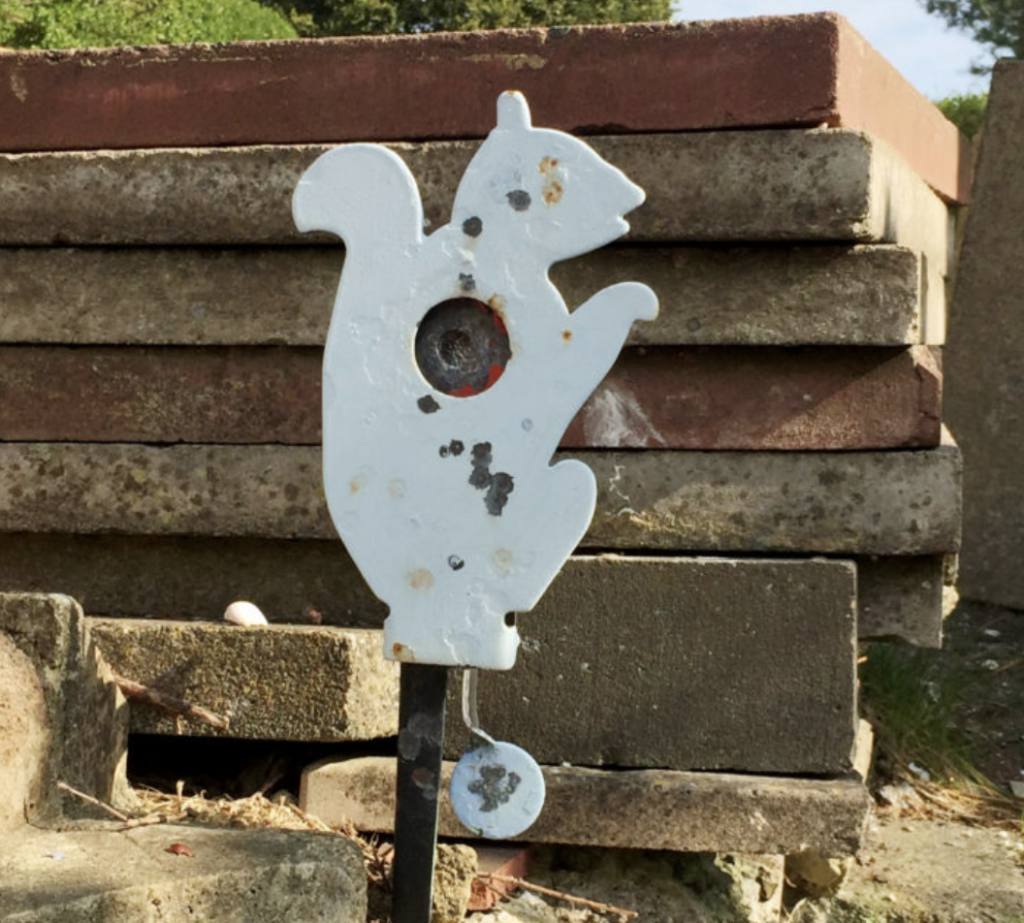
This squirrel target presents a challenging shot, and the stacked paving slabs behind it ensure that any missed shots are stopped dead
The object of the exercise is to give them advance warning about you and your sport so they won’t be alarmed when you do start shooting. Looking out of a window and seeing someone with a gun in their hands can be a worrying experience for a non-shooter, so it’s best to put their mind at ease beforehand.
It’s important to emphasise the fact that you’re a safe shooter and you’ll only be shooting at targets with a proper backstop – you’ll probably have to explain what that means and why it’s important.
Having insurance isn’t a legal requirement, but apart from the peace of mind it gives you, it also lets others know that you take your sport seriously, so when speaking to your neighbours always show them your BASC or other insurance documentation.
This reinforces the fact that you are a sensible, responsible and careful shooter. You can even invite them into your garden to inspect your setup – and maybe offer to let them have a go themselves.
It’s also important not to abuse the relationship you’ve just built up. I won’t start shooting if I know my neighbours are already out in their own garden, and will wait until they’re back indoors.
It’s not a legal necessity, just the application of a bit of common decency and common sense. Even though we know we’re shooting safely, it can’t be much fun for our neighbours to hear pellets whizzing around close by while they’re out in their garden. They should feel relaxed about our shooting, not intimidated.
Noise
Noise is one sure-fire way to put you at odds with the people living next door, so look for ways to minimise the sound of the gun firing and the sound of the pellet striking the target.
How much of an issue this will be depends on how close your nearest neighbours are to you, with a worst-case scenario being an urban garden setting with neighbours living close by either side and also backing on to you.
A moderated PCP or moderated CO2 gun will naturally be the quietest option, so if you want to have an extended shooting session, a gun like this is the way to go.
Springers and gas-rams, even with a moderator fitted, will still be louder than a PCP, so you may want to restrict the amount of shooting you do in any one particular session with guns like these.
Noise is also a concern depending on the type of target that’s being shot. Any metal target will make a loud noise when struck – and that includes knockdown targets and spinners as well as pellet-catchers.
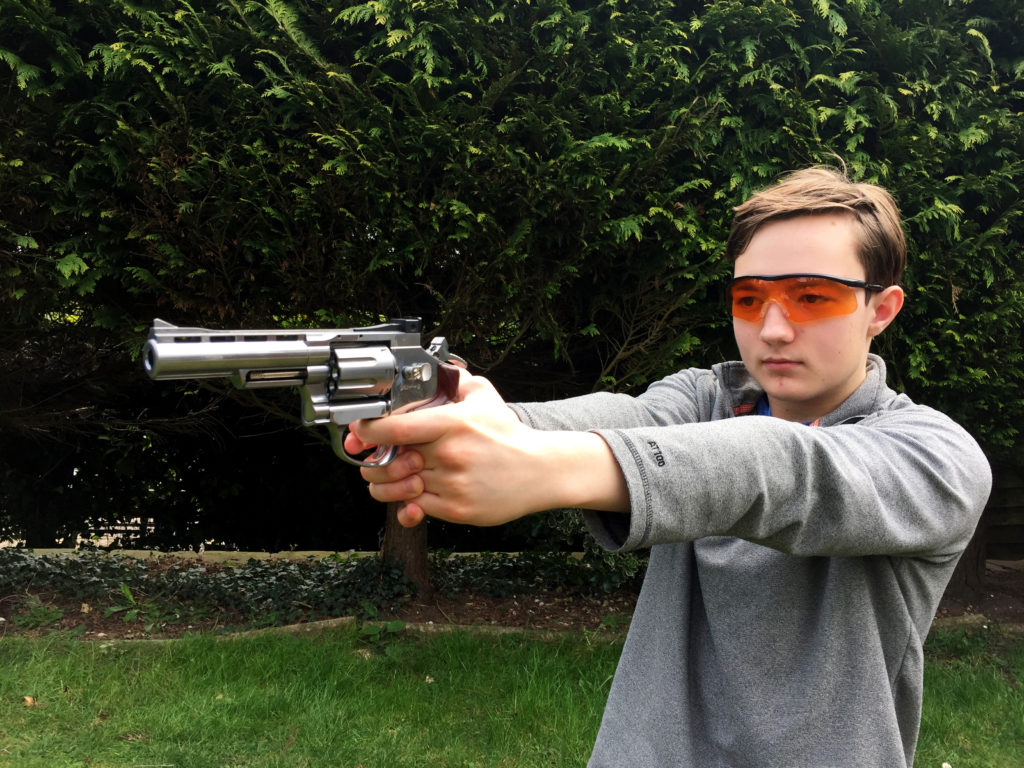
The garden range is great for introducing youngsters to the sport while also providing them with some self-discipline and focus
It doesn’t really matter what calibre airgun you’re using, as they are all capable of delivering a solid smack upon impact. It really is a case of not taking too many shots and abusing your neighbours’ good nature. (Read these tips on setting up an air pistol range.)
Pellet-catchers, on the other hand, can easily be modified to be quieter when hit. One of the most popular designs is the square funnel-shaped model that has a slot at the front to accept a target card.
Commercially made target-holders and pellet-catchers like this are brilliant at doing the job they’re designed for, but the sound of a pellet cutting through the target card and striking the steel behind can be very loud.
The simplest method to quieten them down is to take some old clothes, fold them up and place them inside the pellet-catcher behind the target card. Scrunched up clothes won’t work as well because there will be gaps, while neatly folded clothes will provide a denser layer that will better absorb the strike of the pellet and deaden the sound.
A step up from this is to line the pellet-catcher with sections of carpet tile that have been cut to size. It’s best to make a paper template first so you can work out the exact shape, then glue the templates to the back of the carpet tile and cut out the sections you need with a sharp blade, such as a Stanley knife.
Once the catcher has been lined, you can go ahead and add the folded-up clothes like before. Carpet does have some sound-deadening qualities, but it won’t work well enough on its own, so it’s better to add the old clothes as well.
Alternatively, you can make your own target-holder/pellet-catcher using nothing more than a shoebox, some more of those old clothes and a kitchen chopping board.
Saw the board to size and use it to line the bottom of the shoebox, then fill the box with folded clothes. A target card can be taped to the lid and the completed pellet-catcher placed in front of a safe backstop.
A chopping board on its own is not suitable for shooting with an airgun, because while some pellets will embed themselves in the board, others may ricochet off the hard plastic surface. Chopping boards are excellent when used as a backing board, however.
It’s amazing how well the shoebox pellet-catcher works. It’s near-silent when struck and does a superb job of stopping pellets of all calibres. Just like a backstop, it’s important to regularly inspect a pellet-catcher for damage, replacing any shredded layers of clothing before the next session.
If you want to use the shoebox pellet-catcher in the rain, you can always cover it in cling-film or some sort of heavy-duty tape. But cardboard and clothing will still absorb moisture to some extent, so it’s best to store these materials indoors when your shooting session is over.
Smaller gardens
If your garden isn’t big enough to cope with a regular sub-12 foot pound rifle, then consider shooting airguns of lower power.
Some rifles are available with a muzzle energy as low as six foot pounds – and pistols can have a maximum muzzle energy of six foot pounds, but many are far less than that.
Pick up a CO2 gun and the energy will usually be far less again, making these a good choice for shooting in a smaller garden.
Think about your own safety too when shooting in restricted spaces, especially eye protection. I have my own self-imposed set of rules and will always wear safety glasses when shooting pellets at 10 yards or less, or at any distance when shooting BBs.
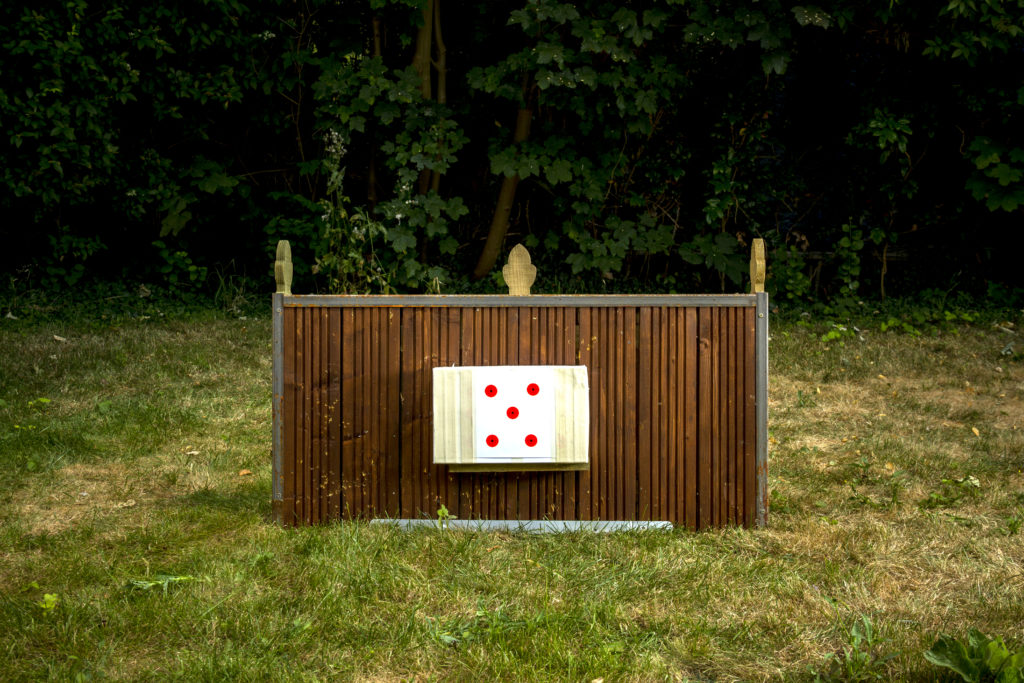
Mike used to use medium-density wood as a backstop, but this is far from ideal: soft woods won’t stop a pellet, while hard woods can cause ricochets
BB guns
It’s no secret that steel BBs present much more of a ricochet risk than pellets, so it’s imperative to use a good ammo-catcher at closer distances. It’s also worth trying some frangible BBs like Dust Devils.
These BBs shatter on hard surfaces on impact, minimising the risk of ricochets, and they’re also lead-free. They may not cycle in all BB guns though, so you’ll have to experiment to see if they work properly in your particular gun.
Metal targets
One of the many joys of shooting on the garden range is the ability to set up and use numerous types of spinners, knockdowns and other reactive targets.
One of my favourite types of spinner is a double-target affair consisting of a rabbit’s head and counterweight on one side of the spinner, and a pigeon’s head and counterweight on the other. You can shoot the smaller counterweights too, so this single device offers a total of four different targets.
The key thing with any type of target where the spent pellet is not being contained is to know where that spent ammo is ending up. If you have a new target, it’s a good idea to set it up in a secure area, shoot a set number of pellets, then retrieve them all afterwards.
Assuming all shots were on target rather than hitting the backstop, you will most likely find the spent pellets will have fallen to the ground immediately beneath and in front of the target, and certainly not more than half a metre away. If you can’t account for the pellets, or suspect they may be ricocheting off the target, don’t use that particular target in a garden setting any more.
Family and pets
Whenever you’re shooting in the garden, it’s vital to ensure that nobody is able to walk into your line of fire. Make everyone in your household aware that you’ll be shooting, and lock any gates and garage doors if necessary.
It’s also important to confirm the exact whereabouts of everyone in the house before you start shooting. It’s no good assuming your partner is watching Netflix if it turns out they’re actually down the bottom of the garden doing some weeding.
Pets should either be kept away from the garden when you’re shooting or be kept under strict control. I have a cocker spaniel who is great around guns in terms of not being bothered by the noise, but he’s still not under full control.
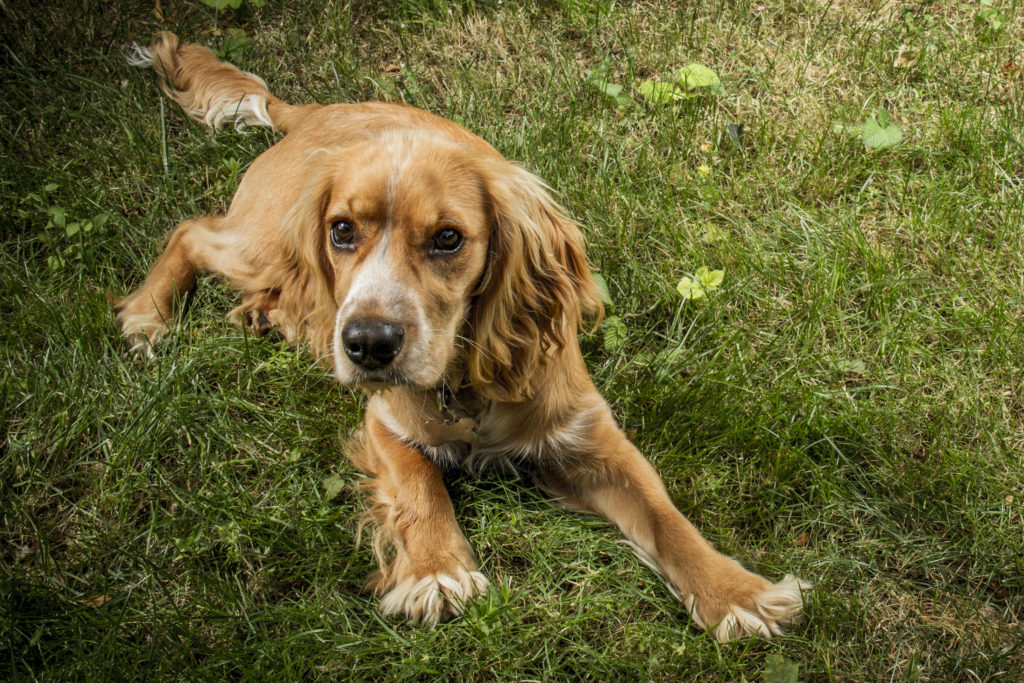
Unless your dog has been properly trained to sit by your side when you’re shooting, it’s best to keep them indoors during your garden sessions
While he’s happy to stay by my side most of the time, nothing would hold him back should a woodpigeon, squirrel or fox enter his territory, so I keep him indoors when I’m shooting.
Cats can be a real problem because they have a knack of arriving in your garden suddenly and silently. You may have a perfectly positioned target and backstop, but a nearby bush can easily hide the arrival of a feline, so you need to be vigilant.
Cats can also make an unwelcome appearance at the firing point. They’re especially hard to see if you’re shooting prone and are in the aim when they arrive.
For this reason I never shoot prone on my own. Instead, I ask a friend or family member to keep a lookout for me, shouting out ‘Cat!’ whenever they spot one.
Dealing with distractions
One of the joys of shooting is the way in which your mind is focused so firmly on taking the shot that all the hustle and bustle of everyday life is temporarily cast aside.
But reality has a nasty way of intruding on your concentration, with your phone ringing, people coming to the door or family members calling out for you. These are all things that you’re unlikely to encounter on a formal range, but you’ve got to be disciplined when they happen on your garden range.
Whenever you find yourself distracted in a situation like this, always deal with your gun first, making it safe either by removing the magazine and/or firing any chambered round into your target or backstop. Only then should you deal with the distraction.
Introducing new shooters
A garden range offers a wonderful opportunity to introduce people to the sport in a relaxed setting who would either never have thought to try shooting in the first place, or just wouldn’t contemplate joining a club.
It’s a great way to bring families together too. But it’s important to remind everyone that although the garden is an informal place to shoot, safety comes first.
Read Mat Manning’s advice on garden airgunning too here.








